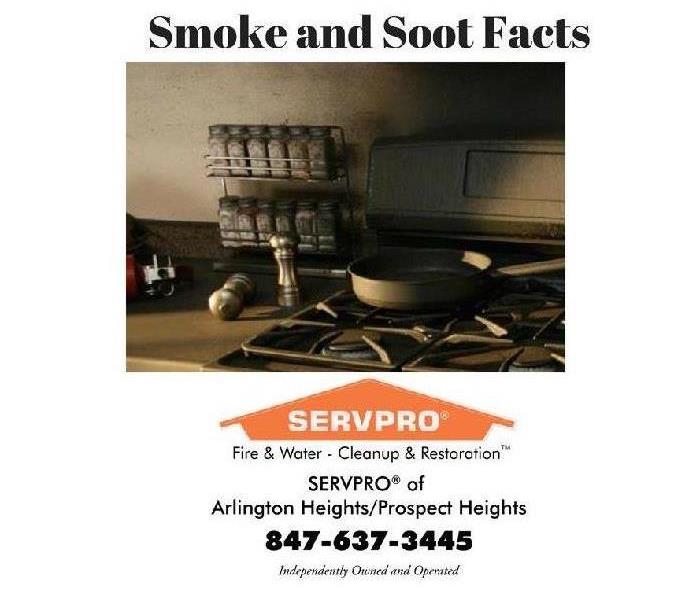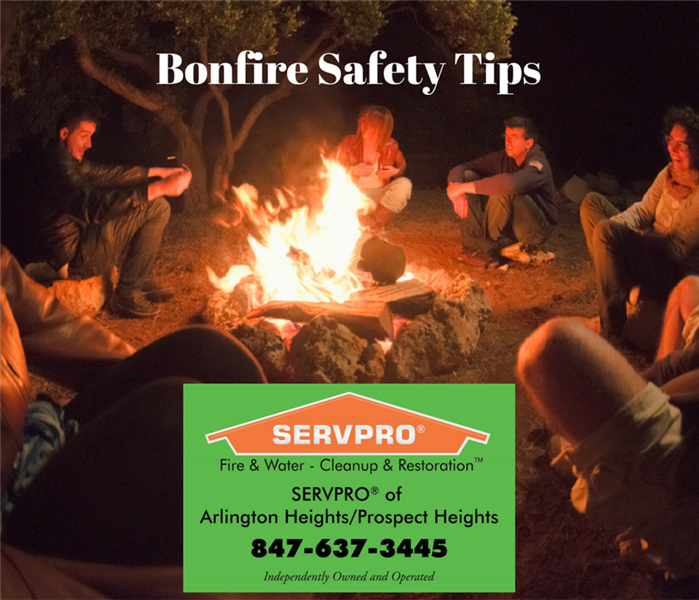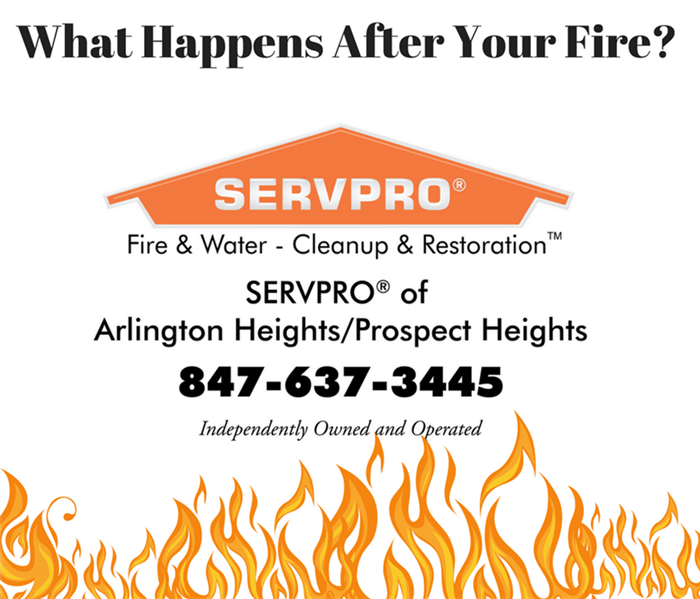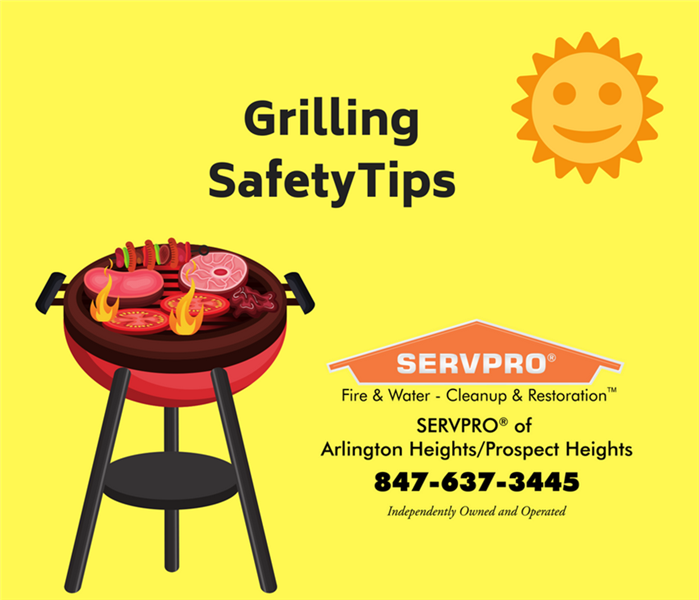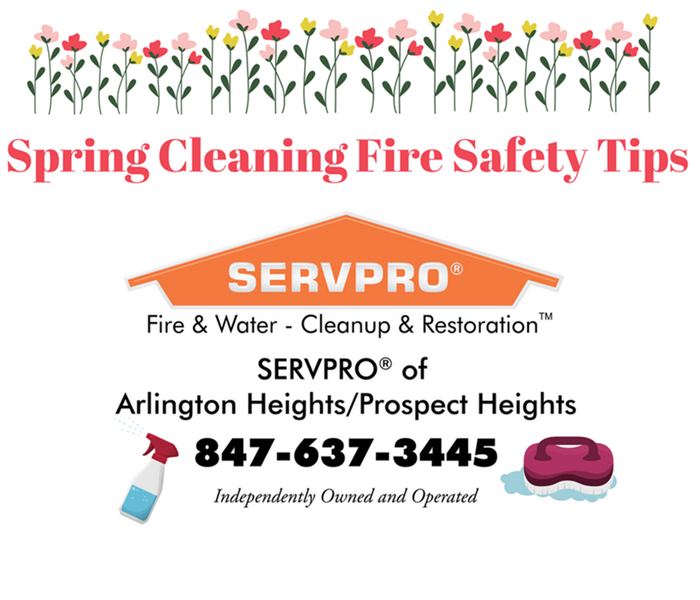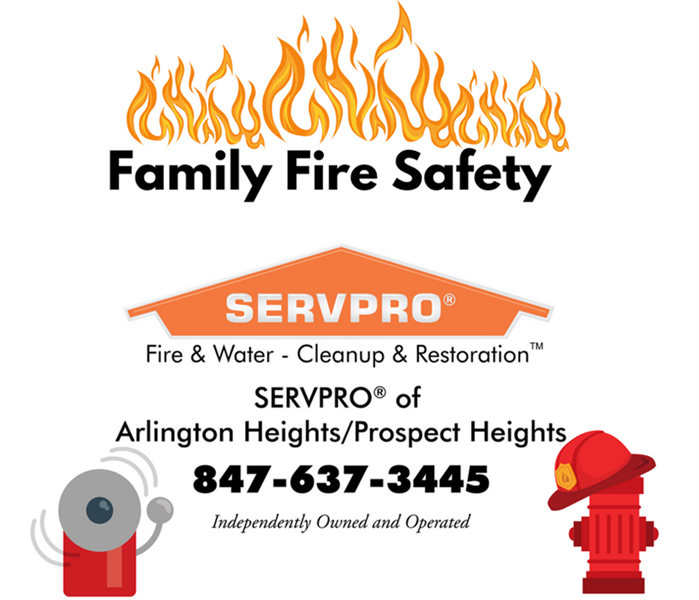Archived Fire Damage Blog Posts
Thanksgiving Safety Tips for a Joyful Celebration
11/27/2024 (Permalink)
Every November, families come together to celebrate Thanksgiving with a delightful feast. However, it's crucial to prioritize safe cooking habits to prevent any mishaps that could turn your joyous holiday into a dangerous situation. According to the National Fire Protection Association (NFPA), cooking is the leading cause of home fires and injuries, with Thanksgiving being the peak day for cooking-related emergencies. Here are some essential safety tips to ensure a safe and happy holiday.
Stay Attentive While Cooking
- Never leave cooking food unattended. Always stay in the kitchen when frying, grilling, or broiling. If you need to step away, even briefly, turn off the stove.
- Regularly check on your food while it's cooking and remain in the home while kitchen appliances are in use. Setting a timer can help remind you that the stove or oven is on.
Create a Safe Cooking Environment
- Establish a “kid-free zone” around the cooking area. Keep small children at least three feet away from the stove and oven to prevent accidents.
- Keep flammable items such as potholders, wooden utensils, and food packaging away from heat sources in the kitchen.
Dress Safely and Maintain Cleanliness
- Avoid loose clothing or dangling sleeves while cooking to prevent them from catching fire.
- Regularly clean cooking surfaces to avoid grease build-up, which can ignite.
Be Prepared for Emergencies
- Invest in a fire extinguisher for your kitchen and familiarize yourself with its use. If you're unsure how to operate one, contact your local fire department for training.
- Before going to bed or leaving the house, always check that all kitchen appliances, including stoves and toasters, are turned off.
Ensure Proper Safety Equipment
- Install smoke alarms near the kitchen, on every level of your home, and in or near sleeping areas. Test them monthly to ensure they are functioning properly and replace the batteries at least once a year.
Our team at SERVPRO of Arlington Heights/Prospect Heights wishes you a safe and joyful Thanksgiving and holiday season! Enjoy your time with family and friends while keeping these safety tips in mind.
Here to Help
9/21/2023 (Permalink)
The first 48 hours following a fire incident are crucial in determining whether your property and personal belongings can be restored or will need to be replaced. SERVPRO's 1-4-8 Service Response Guidelines are designed to minimize long-term issues caused by fire damage. SERVPRO Franchise Professionals offer prompt mitigation services, including fire, smoke, and soot removal, contents claims inventory, and document restoration. These services aim to restore your property, belongings, and cherished memories to their preloss condition whenever possible. SERVPRO Franchise Professionals are available round the clock, 365 days a year, to help you regain control swiftly. In the meantime, you can follow these steps until a service provider like SERVPRO arrives:
- Limit movement within your home to prevent the spread of soot particles and further damage.
- Place clean towels or old linens on rugs, high traffic areas, and upholstery.
- Apply petroleum jelly or oil to chrome faucets, trim, and appliances.
- Insert aluminum foil or wood blocks between furniture legs and wet carpet.
- Avoid washing walls or painted surfaces.
- Refrain from shampooing carpets or upholstery.
- Do not attempt to clean any electrical equipment.
- Avoid sending clothing to a dry cleaner, as improper cleaning methods may set the smoke odor.
Restoring Your Property After A Fire Damage Event
9/5/2023 (Permalink)
Early on Monday, August 28th, a house suffered significant damage when a fire broke out and rapidly spread from a second-floor balcony, as confirmed by officials. Consequently, the home was deemed uninhabitable and required extensive mitigation and restoration work.
Upon receiving the distress call about the fire, our franchise promptly responded to ensure the safety of everyone involved and to assess the structural integrity of the house. Our team made concerted efforts to salvage any valuable or sentimental belongings that were still recoverable. The homeowner expressed great satisfaction with SERVPRO's diligent efforts in retrieving important items from the affected property. This exemplifies our commitment to providing comprehensive assistance in times of need.
Fire and water damage incidents at residential properties often present complex challenges, encompassing various issues that demand a knowledgeable and adaptable response. Regardless of the scale of the damage, whether it be a minor water cleanup or a large-scale event, we act swiftly to evaluate each unique situation and isolate the affected area. In many cases, we can facilitate the continuation of normal operations by setting up temporary spaces while restoring your facility.
Restoring residential properties poses distinct challenges, and our professionals are well-equipped to navigate the legal and environmental considerations while working within your budgetary constraints. We understand that time is of the essence, as every hour spent on cleanup equates to lost revenue and productivity. Therefore, when faced with an emergency situation in your business, do not hesitate to reach out to us. We will respond promptly, providing the assistance you require.
About SERVPRO of Arlington Height/Prospect Heights Specializing in the cleanup and restoration of commercial and residential properties following water damage events, SERVPRO of Arlington Height/Prospect Heights boasts a highly trained staff in property damage restoration. Our team undergoes comprehensive training at SERVPRO's corporate training facility and holds regular IICRC-industry certifications, ensuring that they possess the necessary expertise to restore your property efficiently.
National Pet Safety Day
7/13/2022 (Permalink)
Established in 2009 by The American Kennel Club in association with ADT security Services. National Pet Safety Day was invented to educate pet owners on how to prevent fires and prepare for unexpected emergencies. An emergency can happen at any moment, and you may never be able to fully prevent such events. However, you can prepare yourself and pets for when emergencies do take place. Here is a list of tips that will help your furry friends when a fire takes place.
- Fire alert window clings help firefighters identify the room your pets are located and identify the number of pets in the home. Add one to the window of the room you keep your pets when you are away. Keep it updated with the number of pets residing with you and your current phone number. Last year SERVPRO teamed up with local fire departments animal hospitals to provide sticker for our local communities.
- Make sure to pet-proof your home. Ensure there are no areas where pets can start fires accidentally. This includes removing stove knobs, loose wires, replacing open flame candles with flameless candles, and extinguishing open flames such as fireplaces and other potential hazards in your home. Never leave a pet unattended with a lit candle or fireplace.
- Establish an emergency evacuation plan. Store leashes and collars near the entrance of your home. When away, have your pets in the main living area for easy rescue. Instead of leaving you pets at home unattended contact your veterinarian for a list of preferred boarding kennels and facilities. Also, ask your local animal shelter if they provide emergency shelter or foster care for pets. Identify hotels and motels that accept pets and ask friends and relatives in your area if they would be willing to take your pet in case of an emergency.
4th of July Weekend
7/1/2022 (Permalink)
As the 2022 Independence day weekend begins many Americans are setting up plans for barbeques / Cook outs, festivals and Fireworks.
Did you know that different states have different laws on the sales, operation and even possession f fireworks? Illinois has one of the more strict laws on fireworks as opposed to our neighboring states.
Your local SERVPRO franchise professionals want you to have an enjoyable and safe summer. So here's what you need to know before planning your 4th of July firework show. Consider the following tips to help ensure your summer celebrations are disaster-free.
- Enjoy a Professional display. The safest way to enjoy fireworks is to attend a public display conducted by trained professionals
- Wear protective equipment. Anyone using fireworks or standing nearby should wear protective eyewear.
- Only use LEGAL Fireworks. Only buy, own and operate fireworks that are approved by you state. In Illinois Consumer fireworks may be purchased and displayed only by adults who have obtained permits from their local jurisdiction
- Keep fire extinguishers handy. Keep one in potentially risky areas and make sure everyone knows how to use one. Don't forget to place a bucket of water or sand nearby incase of an emergency.
- Never leave cooking food unattended. cooking is one of the leading causes of home fires. Stay in the kitchen or near the grill when cooking.
- When using a charcoal grill, let the coals completely cool before disposing in a metal container.
- Do not try to re-light or handle malfunctioning fireworks. Keep a bucket of water nearby to fully extinguish fireworks that don't go off or in case of fire. Children should never pick-up fireworks that may be left over as they may still be active.
The safest way to enjoy fireworks is to attend a public display conducted by trained professionals. If your residential or commercial property suffers from structural fire damage, call your local SERVPRO franchise professionals to help make it "Like it never even happened."
10 Safety Tips to Prevent a Dryer Fire
3/13/2022 (Permalink)
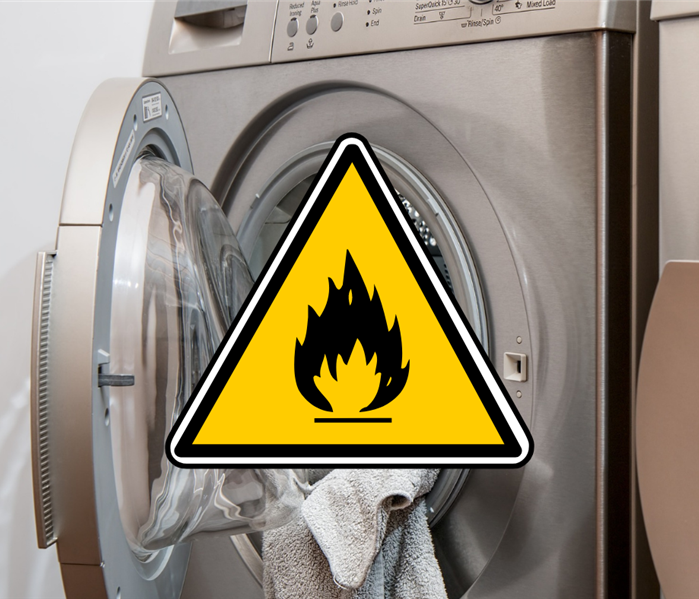 Consider running the dryer only when you are home and awake for your own safety.
Consider running the dryer only when you are home and awake for your own safety.
We usually wash and dry our clothes on a daily or weekly basis. However, it is critical to keep your clothes dryer in good working order in order to keep your home and family safe. Avoiding these specific bad habits can help you avoid a potentially disastrous house fire.
- Installation by a Professional
Professional technicians can ensure that your dryer is installed correctly and carefully. These professionals should be knowledgeable about a wide range of units, including gas and electric dryers, as well as washer/dryer combos. Most manufacturer recommendations, such as proper vent pipe installation, are familiar to these technicians.
A technician would explain how minimizing bends in the pipe is important because it creates fewer opportunities for lint to accumulate. They can install a dryer vent fan for you if the distance between the vent and your dryer is significant. This is an automatic electric device that increases airflow through the duct whenever the dryer is turned on. Having a professional install and service your dryer unit can help ensure that any potential hazards are handled correctly.
- Ongoing Maintenance
According to experts, the primary cause of clothes dryer fires is a failure to clean and maintain them. Check behind the dryer, where lint tends to accumulate. You should clean your dryer once a year and inspect the hose and vent for blockages twice a year.
It is a good idea to have a qualified service person clean the interior of the dryer chassis once a year. This will reduce the amount of lint that accumulates while also providing you with a professional opinion on the safety of your unit. In addition, a professional can inspect the venting and exhaust system. Employ only certified dryer exhaust technicians to ensure that this procedure is carried out correctly.
- Keep Flammables to a Minimum in the Surrounding Area
Dryer lint is not the only flammable that should be considered and kept away from the dryer unit's heat. Anything flammable should be swept up and disposed of before it accumulates and creates a fire hazard. Cleaning up dust and lint is time-consuming, but it is far less difficult than dealing with the aftermath of a fire.
On the same note, do not store cleaning products, boxes, or clothing baskets near the dryer because they may start a fire that spreads quickly. While this is an extreme case, keeping the area clutter-free is an important step toward fire prevention.
- Remove and clean the lint filter before and after each load of laundry.
Household dust and lint are the most common sources of ignition in dryer fires. They congregate within the dryer cavity, which is located near the heating elements. Temperatures can reach 550° here, which is hot enough to start a fire. It is never a good idea to forget to clean out your lint filter.
Cleaning the lint screen before and after each drying cycle is a good habit to get into during your laundry routine. This is an obvious first line of defense in the prevention of dryer fires. Wiping down the interior of the dryer will also remove excess lint buildup that the screen does not catch. This is a less obvious step that many people overlook, but it is nonetheless critical.
It is also critical that you never use a dryer without a lint filter, as this removes the dryer's built-in defense against hazardous lint buildup. This may seem obvious, but you'd be surprised how frequently it occurs.
- Only use metal venting material that is rigid or flexible
Most clothes dryer manufacturers recommend using flexible or rigid metal venting material to maintain proper drying time and airflow. Lint can accumulate in accordion-style ductwork, causing clogs and increasing blockages. Any dryer venting made of plastic or coiled wire foil should be replaced immediately with rigid non-ribbed metal ducts. Purchasing from a reputable vendor is critical to ensuring that your unit meets the necessary safety standards.
It is always a good idea to do your research on any major appliance before purchasing it. Looking at the unit's website to ensure it is from a reliable source, as well as researching customer reviews, can help you make an informed decision.
- Ensure that the air exhaust vent pipe is not obstructed
One of the leading causes of dryer fires is clogged dryer vents. When the vents are clogged, it is difficult to tell. Some people are completely unaware that the vents must be cleaned on a regular basis. However, it is critical to understand that lint accumulates on a large scale within the hoses and, when combined, can cause a serious problem. The accumulation restricts airflow, which can lead to overheating and fire.
In between professional inspections, clean the outside exhaust vent regularly. It is best to check this when your dryer is running by making sure that the exhaust air is escaping properly. If you cannot feel any air, it is likely that there is a lint accumulation clogging the vent outlet. This might require you to disconnect the exhaust vent from the dryer to remove the clog. Remember to reconnect the ducting to the outside vent and dryer before you use the dryer again. If you are unsure of how to do this, it is always recommended that you contact the manufacturer for help or hire a professional.
- Avoid Overloading
Laundry is easy to put off, especially if you have a busy schedule. However, this can lead to you saving all of your dirty laundry to be cleaned on the same day, and it's easy to use this as an excuse to overload your dryer, which can be dangerous.
A heavy load is too much for the dryer and is the most common reason for it to break down. Aside from downtime and repair costs, an overloaded dryer can cause the drum belt, spindle bearings, and pulleys to work overtime, resulting in higher-than-normal temperatures. When this occurs, the friction can ignite a spark, resulting in a fire.
This may be the most straightforward cause of dryer fires and malfunctions to avoid. Maintain organization by limiting your laundry loads to a few times per week. If your schedule makes this difficult or unreasonable, it may be better to simply split your laundry load into two or three loads instead, and take a slightly longer (albeit safer) time to complete this necessary chore.
- Examine Gas Lines
Qualified professionals should inspect the gas line and connection to ensure that they are leak-free and in good working order. Aside from a dryer fire, gas leaks are extremely dangerous and can cause a variety of problems. If you notice a burning odor when using your dryer, stop using it immediately and contact the manufacturer as soon as possible. At all times, stay away from the suspected gas leak area.
- Use the Proper Plug and Outlet
Dryer grounding is critical to their proper operation. Check that you are using the correct electrical plug and outlet as specified by the manufacturer. A licensed professional installing your dryer unit is a good way to ensure that you are doing this.
Check all connections on a regular basis and keep an eye out for any changes. If anything appears to be wrong, loose, or discolored, stop using it right away. Overloaded electrical sockets frequently cause tripped circuit breakers or blown fuses, which can result in a house fire.
- Never use the dryer when you are leaving the house or sleeping.
We've all succumbed to convenience and thrown a load of laundry in the dryer before heading to work or running errands. However, if a fire starts while you are away, you will be unable to put it out. Furthermore, if you are sleeping, it may be too late for you to realize that your house has caught fire.
Consider running the dryer only when you are home and awake for your own safety. It's also a good idea to keep a fire extinguisher in your laundry room in case anything goes wrong.
The Fire Hazards of Winter!
1/5/2022 (Permalink)
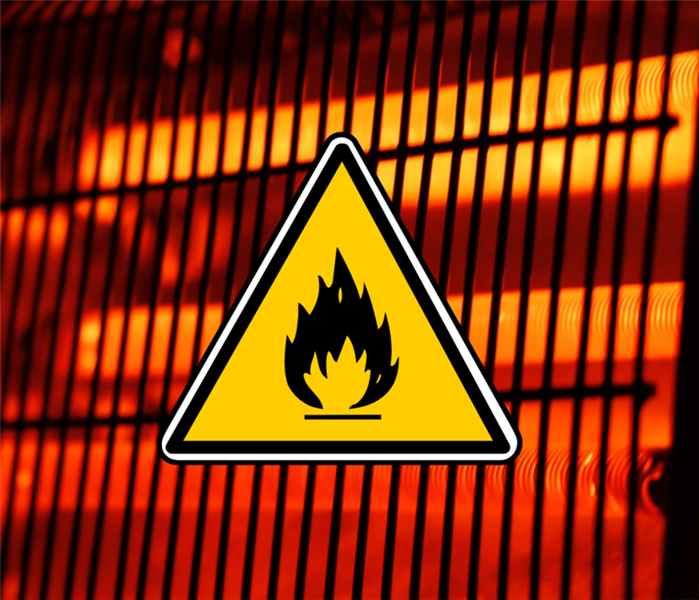 Anything that can burn should be kept at least three feet away from heating equipment!!
Anything that can burn should be kept at least three feet away from heating equipment!!
Keeping ourselves and our houses warm during winter can rapidly turn into a fire hazard, whether it's with a space heater, candles, or an electric blanket. There are various things you can do to make your home more fire-safe, as well as activities you can personally adopt to assist you to stay safe this winter.
Candles
- Candles should be kept at least 3 feet away from anything that can catch fire.
- Place candles in robust holders and in places where they won't be easily knocked over.
- Make sure that candles are out of reach of youngsters and dogs.
- If you leave the room, fall asleep, or go to bed, extinguish all candles.
Electrical equipment/appliances
- Only use one wall outlet at a time to plug in a heat-producing gadget (coffee maker, space heater, microwave, etc.).
- When using a heat-producing appliance, never utilize an extension cord.
- Extension cords should only be used for a short period of time.
- Furniture, beds, curtains, clothing, and flammable or combustible gases and liquids should all be kept away from lamps, light fixtures, and light bulbs.
Heaters
- Make room for space heaters! Anything that can burn should be kept at least three feet away from heating equipment (furnace, fireplace, wood stove, portable heater, etc.).
- When you leave the room or go to bed, turn off the space heater.
- A competent specialist should clean and inspect your heating equipment and chimneys once a year.
- Never heat your home using an oven.
Always make sure you have a working smoke and carbon monoxide alarm at all times in case of a fire.
Safety Tips for Deep Frying a Thanksgiving Turkey
11/3/2021 (Permalink)
 Safety tips to protect yourself, your loved ones, and your home.
Safety tips to protect yourself, your loved ones, and your home.
It’s November, so it’s time for turkey!!!
Deep frying is the newest trend in Thanksgiving turkey preparation. The outcomes can be wonderful, but the process can be risky. I will explain why deep-frying is dangerous and share safety tips to protect yourself, your loved ones, and your home.
Why deep fryers can be dangerous
- The fryer has the potential to tip over and spill gallons of heated oil.
- When the turkey is placed into the cooking pot, overfilling the pot with oil produces leakage. If the oil spills onto the burner, the entire fryer will burst into flames.
- When frozen or partially frozen turkeys are placed in the fryer, steam quickly expands, causing the oil to boil over.
- If there are no thermostat controls, the fryer units have the potential to overheat to the point of combustion.
- The sides of the cooking pot, the lid, and the pot handles can become extremely hot, resulting in severe burns.
Deep-Fried Turkey Safety Tips
- Place the turkey fryer at least 10 feet away from your home and away from children and pets. It should never be left unattended.
- Place the fryer on a leveled, flat surface and carefully measure out the amount of oil required.
- Make sure your turkey is totally thawed and dry before cooking.
- Keep an eye on the temperature of the oil and use the fryer with caution. Severe burns from the lid and handle are possible.
- Always keep a fire extinguisher or multipurpose dry powder on hand in case oil catches fire.
Thanksgiving Safety Tips and Fire Facts
11/2/2021 (Permalink)
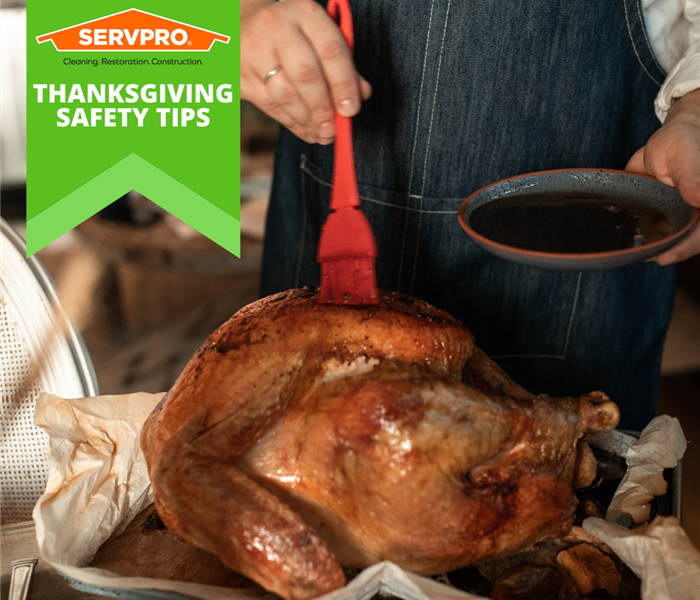 Thanksgiving Safety Tips and Fire Facts
Thanksgiving Safety Tips and Fire Facts
The kitchen is the heart of the home for most people, especially around the holidays. Everyone appreciates being a part of the preparations, from testing family recipes to creating cakes and pastries.
When there's a lot of activity and people at home, it's crucial to keep fire safety top of mind in the kitchen during this festive but chaotic time. As you begin to plan your holiday schedule and prepare a large family meal, keep in mind that by following a few easy safety tips, you can spend time with your loved ones while also keeping yourself and your family safe from fire.
Safety Tips
- While you're cooking, stay in the kitchen to keep an eye on the food.
- The stove will be very hot, so children should keep at least three feet away.
- Keep children away from hot foods and beverages. Vegetables, gravy, or coffee steam or splashes can cause significant burns.
- Make sure that no electric wires from a coffee maker, plate warmer, or mixer are dangling off the counter or within easy reach of a child.
- Matches and utility lighters should be kept out of reach of children, preferably in a locked cabinet.
- Never leave a lit candle alone in a room unattended.
- Check to see if your smoke detectors are working. By using the test button, you can put them to the test.
Thanksgiving Fire Facts
- Thanksgiving Day, the day before Thanksgiving, Easter, and Christmas Eve are the most common days for home cooking fires.
- On Thanksgiving Day in 2018, U.S. fire agencies responded to an estimated 1,630 home cooking fires, the busiest day for such disasters.
- Cooking that was left unattended was by far the most common cause of cooking fires and fire deaths.
Fire Safety Tips for Your Pets
7/12/2021 (Permalink)
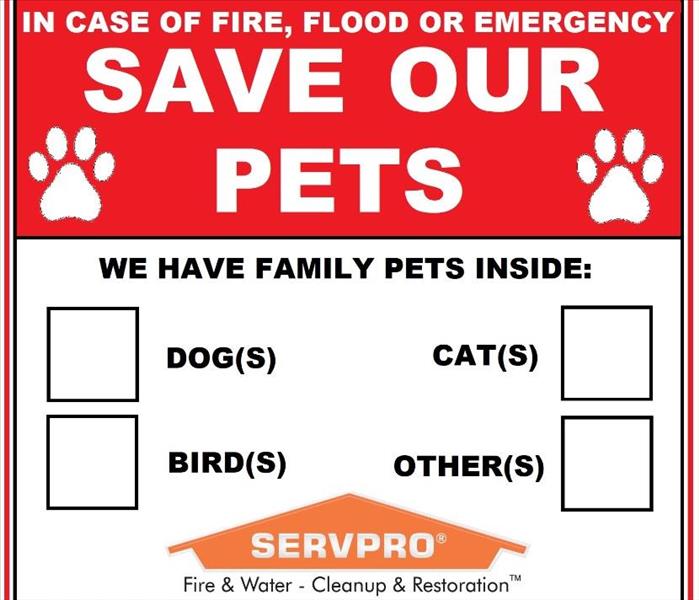 Take action before an emergency takes place!
Take action before an emergency takes place!
An emergency can happen at any moment, and you may never be able to fully prevent such events. However, you can prepare yourself and pets for when emergencies do take place. Here is a list of tips that will help your furry friends when a fire takes place.
- Consider installing monitored smoke detectors! If you live in a fire-prone area, monitored smoke detectors are always a smart choice. This will help the firefighters get a notification, and can respond as quickly as possible. Even if you are not home.
- Make sure to take note where your pets like to nap or hide. This is very important in event that needs evacuation in your home quickly. Remember that pets can be exponentially more difficult to round up if they sense stress. (Especially cats!) Practice crating your pets in advance to make it a positive experience. This will then help prevent them from running when you pull out their crate during any type of emergency.
- You need to have an emergency plan, and practice escape routes with your pet. Make sure to include all members of the family in this plan. Also make sure they know what to do and where to go.
- Have the phone number and address your local animal hospital handy. If your pet is injured, you will need to know where to take them for help ass quickly as possible.
- Make sure to pet-proof your home. Ensure there are no areas where pets can start fires accidentally. This includes stove knobs, loose wires, candles, fireplaces and other potential hazards in your home. Never leave a pet unattended with a lit candle or fireplace.
- If you have to evacuate, make sure to take your pets with you whenever possible. If you leave them behind, they may become trapped or escape and then be exposed to numerous life threatening hazards. In advance, make sure to contact your veterinarian for a list of preferred boarding kennels and facilities. Also, ask your local animal shelter if they provide emergency shelter or foster care for pets. Identify hotels and motels that accept pets, and also ask friends and relatives in your area if they would be willing to take your pet in case of an emergency.
- Get a rescue alert sticker! This easy to use sticker will let firefighters know that there are pets inside your home. Make sure it is visible, and we recommend placing it on or near your front door. This sign will include the types and number of pets in your home.
We here at SERVPRO have teamed up with local fire departments and animal hospitals to provide people with these stickers!
Summer BBQ Grilling Safety Tips
7/8/2021 (Permalink)
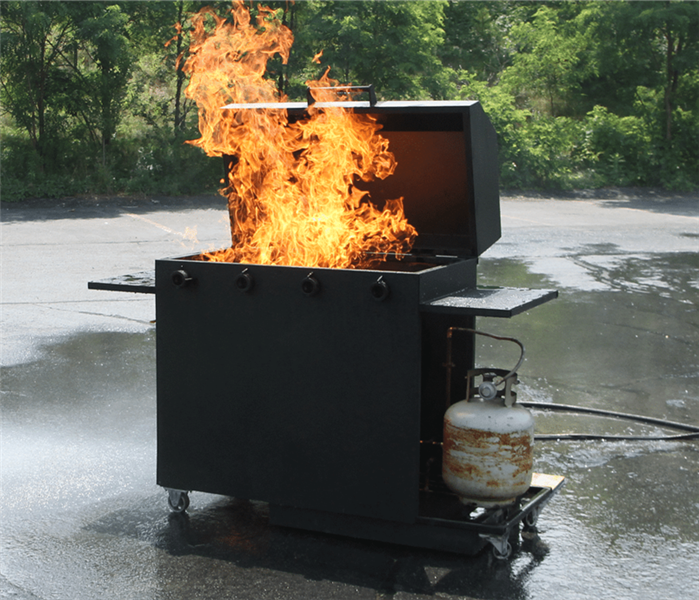 Fire safety for summer BBQ's!
Fire safety for summer BBQ's!
Grilling outside on a hot summer day is one of the most popular cooking methods in the summer. However, each year in the U.S. there are 10,200 home fires that are caused by outdoor grills. According to the National Fire Protection Association, July is the peak month for grill fires. Grill fires can start easily and spread quickly when the gas or charcoal is placed too close to any fire hazards. Here are 9 grilling safety tips for your summer BBQ's.
1. Only use grills outside
You might think it is okay to grill inside of your open garage or under a covered balcony, but propane and gas, charcoal grills are strictly designed for outdoor use where there is plenty of ventilation. If there is any combustible materials that surround or hang over the grill, it can catch fire easily and quickly. Make sure that the area over top and around the grill is clear.
2. Place your grill away from your home
BBQ grills are often placed just outside the back door or on the back deck. You should avoid placing your grill in these areas because it can pose a potential fire hazard. Grills that are placed too close to the house or wood structures can heat up adjacent materials and cause a fire to start. You want to make sure you keep at least 10 feet from your home or other structures.
3. Make sure your grill is located on a flat and level surface
If you place your grill on a slope or other uneven surfaces, it can tip over easily and cause a fire. Make sure that your grill is et up on a stable surface such as a concrete pad so it remains level while in use.
4. Check your grill for leaks
If you store your grill inside during the winter, make sure to check it over thoroughly when grilling season in the summer begins. A leak in the gas lines can cause propane or natural gas to build up inside when the lid is closed. Check the gas lines to make sure that they are free of leaks before using the grill. Make sure you also always open the lid of your grill before lighting.
5. Always clean your grill after use
When you BBQ regularly, it causes grease to build-up on the grill plates and collect inside the grease tray. If it is not cleaned, the build-up can then act as fuel and catch fire while the grill is in use. Clean your charcoal or gas grill after each use with a grill brush and empty the grease tray when it begins to fill up.
6. Never leave your brill unattended while in use
Never leave the grill unattended while you are cooking food. Grills use high heat and open flames to cook food, and when left unattended can become a safety and fire hazard. If you have to leave the grill, ask another adult to watch the grill for you.
7. Wear appropriate clothing
Clothing that has long sleeves or pieces that dangle can catch fire easily when too close to an open flame. When grilling food, wear clothing that won't interfere with the cooking process. Also, make sure that any apron strings are tied back away from the front. If a piece of clothing does catch fire, remember to stop, drop, and roll to extinguish the flames quickly.
8. Keep a spray bottle on hand
It is common for grills to flare up as fat drips from meat as it is cooking. This can cause a section of the grill to remain on fire as it burns away. If left alone, the flames will continue to burn and cause excess smoke to billow out from under the lid. Make sure you keep a spray bottle filled with water beside your grill so that you can quickly extinguish smaller flames before they begin to spread.
9. Always have a fire extinguisher close by
If a fire where to break out, follow these tips on how to put out a grill fire and ensure you have First Alert EZ Fire Spray within reach. It is simple to use, just point and spray to extinguish the fire. The spray is also quick and easy to clean up after use. It's small, compact size makes it the perfect addition to your grilling set to help keep your loved ones safe.
Following these safety tips and having the right protection will help you and your family enjoy a safe grilling season this summer!
Smoking in the home
3/12/2021 (Permalink)
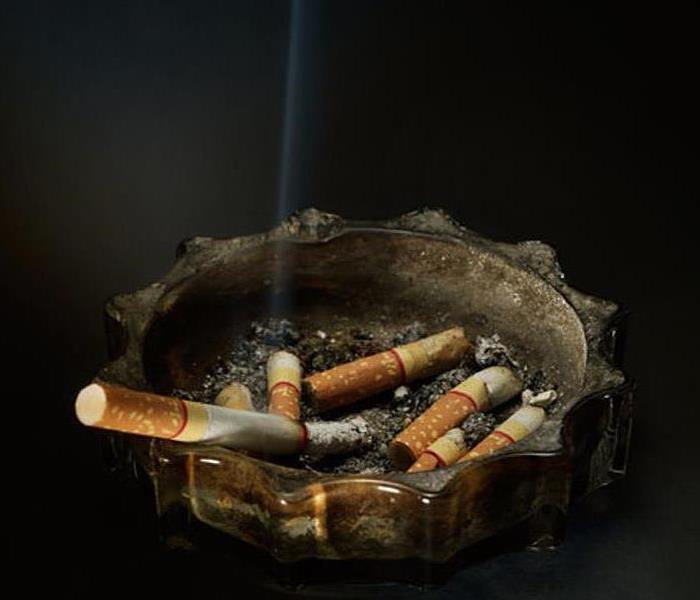 Emergency Response Service 24/7
Emergency Response Service 24/7
According to the National Fire Protection Association, smoking materials that include cigarettes, pipes, and cigars started an estimated 17,200 home structure fires. This was reported from U.S. fire departments. Amongst these 17,200 estimated fires, these fires cause 570 deaths, 1,140 injuries and $426 million in direct property damage. It was also reported that smoking materials caused 5% of reported home fires, 21% of home fire deaths, 10% of home fire injuries, and 6% of the direct property damage. According to the NFPA, most deaths in home smoking-material fires were caused by fires that started in bedrooms or in living rooms, family rooms or dens. It is also a face that the risk of dying in a home structure fire caused by smoking materials rises with age.
With that being said, it is encouraged to use smoking materials outside of the home. Designate a "smoking area" such as the garage or outside. This will help eliminate the risk of a fire starting in the actual home.
Lending a helping hand
1/5/2021 (Permalink)
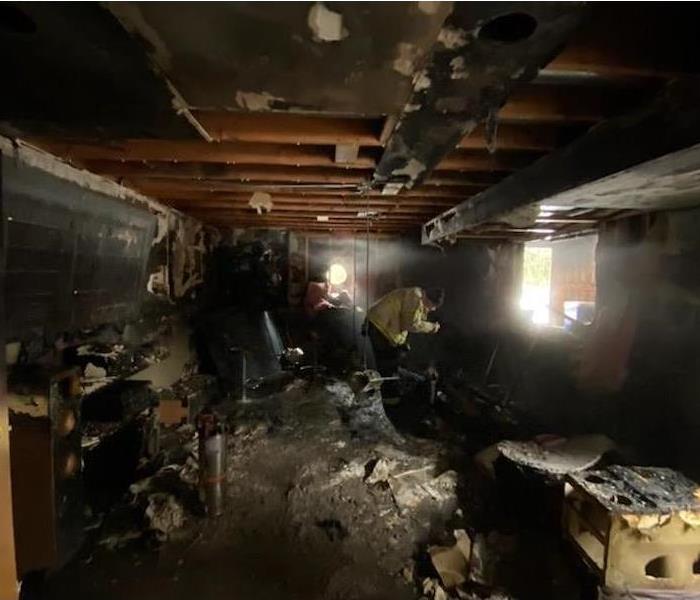 Residential Fire Damage
Residential Fire Damage
We have a really great relationship with our local fire departments, and follow their social media pages. After scrolling through our daily feed, we came across the Addison Fire Department's post about a local fire. What stood out about this post was that our local fire department and other FDs went to help with this major residential fire that took place. The AFPD responded to a house fire, and the smoke detectors did their job by alerting the family of the fire. They were all able to escape safely. They were very thankful for the help from the Wood Dale FPD, Elmhurst FD, and Itasca FPD for coming out to help. The family had told the firefighters that there were two guinea pigs in the home, and they were able to find and save them. The guinea pigs received O2 therapy and vigorous rubbing, and both were successfully resuscitated. The fire started in the basement, and the heat and smoke rose up throughout the house. They enforced to make sure your smoke detectors are working, and the batteries are changed! They also stated to make sure you keep your bedroom doors closed when sleeping, and try not to risk your life to save a pet. That is what the firefighters are for, and they will do their best to rescue them.
The main take away from this message was to always make sure to test your smoke detectors at least once a month, and the batteries should be replaced at least once or twice a year. Also, a huge shoutout to our local fire department for helping out a different fire department in order to get everyone out safely, along with the pets.
Electrical issues are fire hazards
12/1/2020 (Permalink)
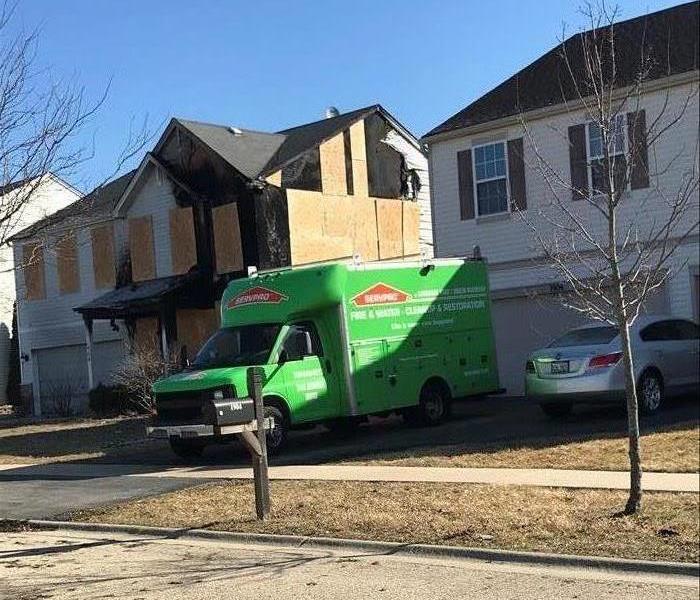 Boarded-up home after electrical fire.
Boarded-up home after electrical fire.
Approximately 2,400 children suffer severe shock and burns when they stick items into the slots of electrical receptacles each and every year - that is almost as many kids on a ball field to play a game (7), children a day. They estimate that 6 to 12 fatalities are recorded yearly due to this. Just by placing ordinary household objects, such as keys, pins, or paperclips into the outlets 1/3rd of the children parish. They are a real danger but we over look them each and every day. Even with new technologies a simple outlet cover can help if you don’t have the means for the TRR’s they produce today.
TRRs look just like ordinary outlets, but are designed with spring-loaded receptacle openings, or slots. When equal pressure is applied to both sides, the receptacle cover plates open to make contact with the receptacle contact points. Without this simultaneous pressure, the cover plates remain closed, preventing insertion of foreign objects and protecting your children from painful, traumatic electrical injuries. This runs about $2.00 more per outlet than a typical standard outlet. If it was new construction it would be a total of $50.00 added to the cost of the home.
Safety tips for the upcoming holidays
11/3/2020 (Permalink)
Per the National Fire Protection Association, nearly 47,000 fires occur during the winter holidays claiming more than 500 lives, causing more than 2,200 injuries, and costing $554 million in property damage. The National Fire Protection Association also states that on average, one of every 22 home fires started by Christmas trees result in death.
www.redcross.org/homefires, has several good home safety tips for the holidays to keep your home safe. We at SERVPRO LaGrange Park/North Riverside wanted to share some of those tips with you to ensure a safe holiday season.
- Place Christmas trees, candles, and other holiday decorations at least three feet away from heat sources like fireplaces, portable heaters, radiators, heat vents and candles.
- Purchase flame retardant metallic or artificial trees. If you purchase a real tree, make sure that it has fresh, green needles that aren’t easily broken. Keep live trees as moist as possible by giving them plenty of water.
- Make sure that light strings and other holiday decorations are in good condition. Do not use anything with frayed electrical cords and always follow the manufacturer’s instructions.
- Always unplug tree and holiday lights before leaving home or going to bed.
- Never use lit candles to decorate a tree. Always extinguish candles before leaving the room orgoing to bed.
- Use only sturdy tree stands designed not to tip over. Keep curious pets and children away from Christmas trees.
- Keep anything that can catch on fire—pot holders, oven mitts, wooden utensils, paper or plastic bags, food packaging, and towels or curtains—away from your stove top.
- Designate one person to walk around your home to make sure that all candles and smoking materials are properly extinguished after guests leave.
The following video also shares other great ideas to keep in mind this holiday season.
Holiday Fire Safety
Have a safe and wonderful holiday season from your friends at SERVPRO of Arlington Heights/N. Prospect
After fire cleanup
11/2/2020 (Permalink)
Smoke and soot is very invasive and can penetrate various cavities within your home, causing hidden damage and odor. Our smoke damage expertise and experience allows us to inspect and accurately assess the extent of the damage to develop a comprehensive plan of action.
Smoke and soot facts:
- Hot smoke migrates to cooler areas and upper levels of a structure.
- Smoke flows around plumbing systems, seeping through the holes used by pipes to go from floor to floor.
- The type of smoke may greatly affect the restoration process.
Different Types of Smoke
There are two different types of smoke–wet and dry. As a result, there are different types of soot residue after a fire. Before restoration begins, SERVPRO of LaGrange Park/North Riverside will test the soot to determine which type of smoke damage occurred. The cleaning procedures will then be based on the information identified during pretesting. Here is some additional information:
Wet Smoke – Plastic and Rubber
- Low heat, smoldering, pungent odor, sticky, smeary. Smoke webs are more difficult to clean.
Dry Smoke – Paper and Wood
- Fast burning, high temperatures, heat rises therefore smoke rises.
Protein Fire Residue – Produced by evaporation of material rather than from a fire
- Virtually invisible, discolors paints and varnishes, extreme pungent odor.
Our Fire Damage Restoration Services
Since each smoke and fire damage situation is a little different, each one requires a unique solution tailored for the specific conditions. We have the equipment, expertise, and experience to restore your fire and smoke damage. We will also treat your family with empathy and respect and your property with care.
Have Questions about Fire, Smoke, or Soot Damage?
Call Us Today – 847-637-3445
Did you know?
7/23/2020 (Permalink)
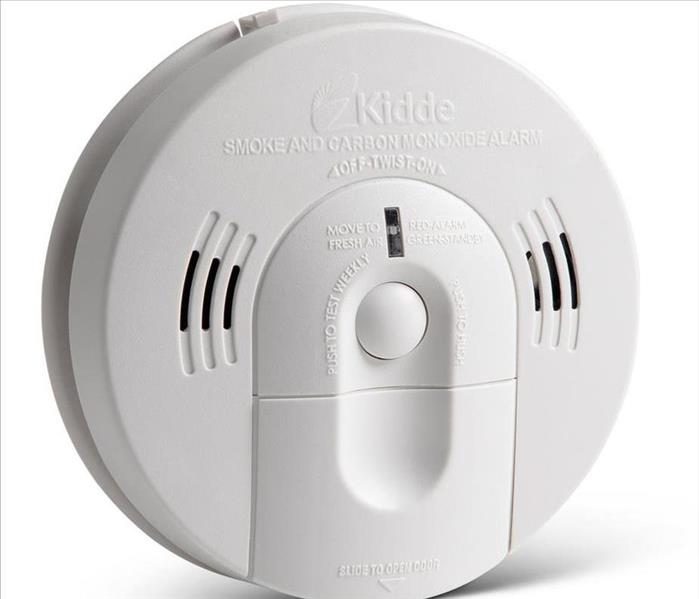 Make sure yours is set up today!
Make sure yours is set up today!
Did you know that local fire departments require carbon monoxide detectors?
The Elmhurst Fire Department requires that each home be outfitted with carbon monoxide detectors, in addition to smoke detectors.
For some people, they may not know this, so here are some helpful tips and steps about the carbon monoxide detector.
First off, Carbon monoxide is a colorless, odorless, and tasteless gas that is poisonous to humans. It is known as the "silent killer" because humans cannot tell when they are around it. The carbon monoxide detector is a safety device that can alert homeowners of a CO leak, and then help them escape a potentially life-threatening situation.
Carbon monoxide can be produced by any fuel-burning device. There are three main sources, and they are your home's furnace, dryer vent in a drying machine, and fireplace or chimney. It is VERY IMPORTANT to have those sources regularly services and cleaned by a professional to help prevent a CO leak.
When it comes to installation of the alarms, it is important to have them on every level of the home. That way all family members can hear the detectors go off. There should also be detectors in every bedroom, sleeping area, and common room for extra safety while asleep. They can be placed anywhere in the room, and can also be placed on the wall or the ceiling and will be just as effective.
Lastly, it is important to test your alarms regularly, so at least once a month. If it has replaceable batteries, they should be changed at least every 6 months. However, just because you replace the batteries doesn't mean they last forever. They have a lifetime of anywhere between 5-7 years.
The most common causes of house fires
7/23/2020 (Permalink)
There are many common causes when it comes to house fires, but there are measures that can be taken in order to avoid them.
Cook equipment that includes pots and pans can overheat very quickly, and they can cause a fire very easily if the person cooking gets distracted and then leaves the cooking unattended. ALWAYS stay in the area where cooking is taking place, or ask someone to water the food when cooking with hotplates.
Portable heaters are another common cause of house fire. Make sure to keep them at least one meter away from anything that could easily catch fire. This would include furniture, curtains, laundry, clothes and even yourself. If you have a furnace, get it inspected once a year to make sure it is working to safety standards.
Make sure to keep bedrooms off limits when it comes to smoking in the home. A cigarette tat is not put out properly can cause a flame, as the butt may stay alit for a few hours once one is done with it. It could burst into flames if it came into contact with flammable materials, such as furniture.
An electrical appliance, such as a toaster can start a fire if it is faulty or has a frayed cord. A power point that is overloaded with double adapter plugs can cause a fire from an overuse of electricity. Also, a power point extension cord can be a fire hazard if not used appropriately. Make sure to double check the appliances and power points in the home.
Candles may look and smell pretty, but if left unattended they can cause a room to easily burst into flames. Make sure to keep candles away from any obviously flammable items such as books and tissue boxes. Always blow out the candle(s) before leaving the room they are in.
Children can cause a fire out of curiosity, to see what would happen if they set fire to an object. Please make sure to keep any matchers or lighters out of reach in order to avoid this. Install a smoke alarm in your child's room and practice a home escape plan with your children and family in case there was a fire.
Homes with inadequate wiring can cause fires from electrical hazards. Some signs to see if you have bad wiring are
-lights dim if you use another appliance
-for an appliance to work, you have to disconnect another
-fuses blow or trip the circuit frequently
Make sure to have a licensed electrician come and inspect your home, or contact your landlord if you have any of the above occurrences.
Make sure when you barbeque to keep it away from the home, tablecloths or any plants and tree branches. Keep them regularly maintained and cleaned with soapy water and clean any removable parts. Check the gas bottle for any leaks before you use it each time.
If you have any flammable liquids in the home or garage such as petrol, kerosene or methylated spirits, keep them away from heat sources and check the label before story. Be careful when pouring these liquids.
Lastly, lamp shades and light fittings can build up heat if they are very close to light globes. Check around the house to make sure. Lamp bases can become a hazard if they are able to be knocked over easily, and so should be removed if they are. Check that down lights are insulated from wood paneling or ceiling timbers.
How To Protect Your Home From Lightning
2/25/2020 (Permalink)
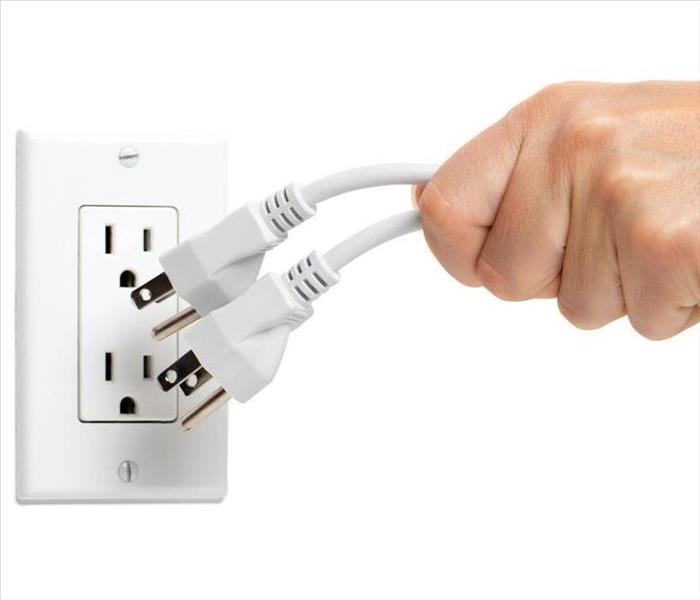 Be sure to unplug all electronics
Be sure to unplug all electronics
Ways Your Home Stays Protected From a Lightning Fire
A typical thunderstorm may not seem like a major cause for concern. However, lightning can have many detrimental effects on your house. The damage caused by a thunderstorm can range from a power surge to a house fire. By taking the proper precautions, you can keep your house safe from any kind of natural disaster. Here are some simple ways to ensure that your Prospect Heights, IL, home stays protected from a lightning fire.
Unplug All Electronics
Many electronic devices are a serious source of danger during a thunderstorm. Because these devices typically use multiple outlets, they run the risk of becoming severely damaged during a storm, which can pose a threat to your entire home. Be sure to unplug the following types of electronics before the storm begins:
- Computers
- Phones
- Flat screen TVs
- Stereo equipment
In addition to unplugging these devices, make sure that they’re not in use during the storm. If lightning hits a telephone pole while you’re talking on the phone, for example, it can send harmful voltage straight to your living space. As a rule of thumb, try to stick to cordless devices like cellphones and laptops to prevent a lightning fire from occurring.
Safeguard Your Home’s Exterior
Keeping the outside of your home protected is just as important as protecting the inside. Be sure to have rods installed on your home’s roof to keep your building safe from the effects of a thunderstorm. Additionally, make sure that there are no tall trees in the immediate vicinity of your home. This can significantly reduce the risk of a fire in your living space. Another effective option is to have a lightning protection system in place, which can ensure that your house stays fully protected during a storm.
In the event that a lightning fire impacts your living space, don’t wait to give your home the full recovery it needs. Experts can conduct a fire damage assessment and bring your space back to normal in no time.
Can Lightning Cause a House Fire?
11/22/2019 (Permalink)
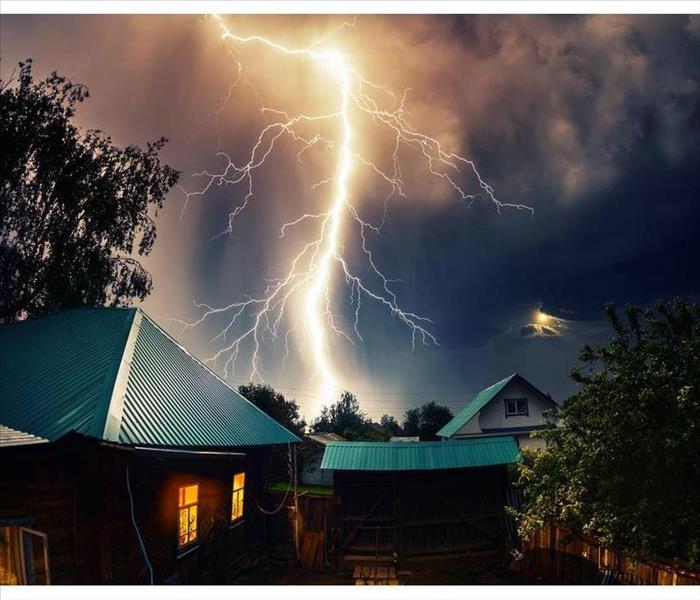 If a lightning fire does harm your home, your local emergency restoration specialists can help with any repairs
If a lightning fire does harm your home, your local emergency restoration specialists can help with any repairs
Can Lightning Cause a House Fire?
You probably know about the indoor dangers that can cause a house fire, such as an unattended pot or a knocked-over candle. Yet fires can also result from weather events that you can't control. A lightning fire, in particular, can be devastating to your Arlington Heights, IL, home.
In fact, thunderstorms, and the lightning they bring with them, can cause more fire damage than you think. Between 2007 and 2011, local fire departments in America responded to an average of 22,600 of these blazes each year. The fires caused an annual average of $451 million in property damage. Here are some more stats you may not have known about these fires.
From 2007 to 2011, they caused an average of 53 civilian injuries and nine civilian deaths each year
While only 18 percent of thunderstorm fires were inside houses, these accounted for 88 percent of the associated civilian deaths between 2004 and 2008
They also create a big need for fire cleanup, as 70 percent of the property damage caused by lightning fires occurred in homes
When Do They Strike?
You are most likely to see a lightning fire in the summer months. This type of blaze is particularly common during late afternoons and evenings.
How Do I Stay Safe?
You are still better off staying inside your house if you hear thunder. No outdoor area is safe during a thunderstorm. Avoid standing under trees or inside small sheds. Instead, get to a sturdy shelter.
Once inside, don’t use any electronics that require an outlet, such as computers and corded phones. You should also avoid bathing, showering, doing the dishes or washing your hands.
Just because the thunder ends doesn’t mean the storm is over, either. You should wait at least 30 minutes after the thunder stops before heading back outside.
No matter the cause of the blaze, fire damage cleanup can be an overwhelming process. If a lightning fire does harm your home, your local emergency restoration specialists can help with any repairs.
THANKSGIVING HOME FIRES
11/18/2019 (Permalink)
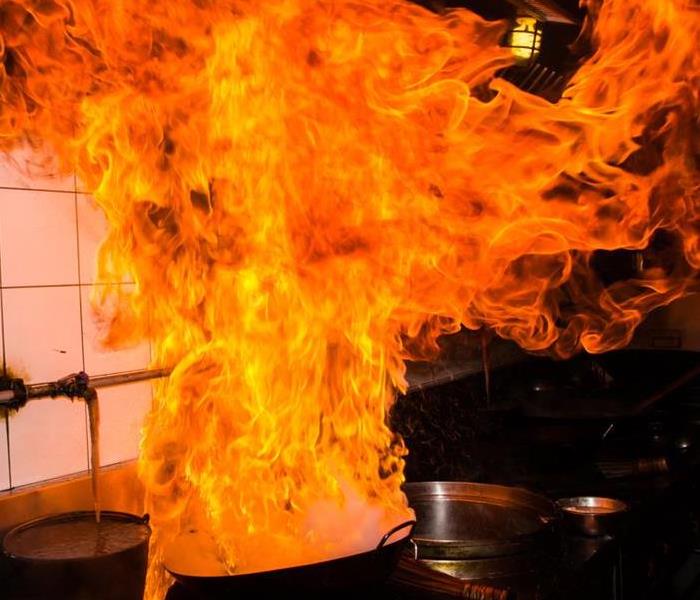 Our SERVPRO of Arlington Heights/Prospect Heights professionals wishes you a safe and happy Thanksgiving and holiday season.
Our SERVPRO of Arlington Heights/Prospect Heights professionals wishes you a safe and happy Thanksgiving and holiday season.
Each November, families gather to celebrate Thanksgiving by preparing a delicious feast,
but if you don’t practice safe cooking habits, your happy holiday could quickly become hazardous in a blink of an eye. According to the NFPA, cooking is the main cause of home fires and injuries, with the Thanksgiving holiday being the peak day for cooking-related fire emergencies. Review the following safety tips to help ensure you can enjoy a safe holiday.
*Never leave cooking food unattended—stay in the kitchen while frying, grilling, or broiling food. If someone must leave the kitchen for even a short period of time, they should turn off the stove.
*Check food regularly while cooking and remain in the home while kitchen equipment is in use. Use a timer as a reminder that the stove or oven is on.
*Keep small children away from the cooking area. Enforce a “kid-free zone” and make them stay at least three feet away from the stove and oven.
*Keep anything flammable like potholders, oven mitts, wooden utensils, paper or plastic bags, food packaging, and towels away from the stove, oven, or other appliances in the kitchen that generates heat.
*Do not wear loose clothing or dangling sleeves while cooking.
*Clean cooking surfaces on a regular basis to prevent grease build-up.
*Purchase a fire extinguisher
to keep in the kitchen year-round. Contact the local fire department for training on the proper use of fire extinguishers if you are unsure.
*Always check the kitchen before going to bed or leaving the home to make sure all kitchen appliances like stoves, ovens, and toasters are turned off.
*Install a smoke alarm near the kitchen, on each level of the home, near sleeping areas, and inside and outside of bedrooms. Use the test button to check it is working properly every month. Replace the batteries at least once a year.
Our SERVPRO of Arlington Heights/Prospect Heights professionals wishes you a safe and happy Thanksgiving and holiday season.
How To Create an Emergency Plan for Your Pets
10/9/2019 (Permalink)
 Practice evacuating in the car with your animals, so they’re more familiar if you need to evacuate in an emergency
Practice evacuating in the car with your animals, so they’re more familiar if you need to evacuate in an emergency
A fire emergency can occur at any time in Arlington Heights, IL. Thankfully, working with a fire restoration company can increase the likelihood that your home returns to normal. Of course, possessions are not the only important aspect of preparing for a fire. Pet safety should be part of your emergency plan, too. Here are a few ways to get started.
Have an Evacuation Plan
Draft an escape plan for your family and include your pets in it. Emergency pet preparation for some animals may involve teaching them to come when called. If you must leave the home in a hurry, your pets will be trained to know what to do and where to go. Practice taking your pets with you during your family fire drill and teach them to respond to commands. For pets that are skittish, have a carrier that you can easily put them in.
Keep Important Documents Together
Have proof of pet ownership with you. This can make it easier to find them in the event that they go missing while also proving that you own them. When putting together a pet safety kit, include the following as well:
- A picture of your pet
- License records
- Vaccination records
Keeping everything in one safe area can eliminate worry and help you feel prepared in a fire emergency.
Alert First Responders
One way to assist first responders is by putting a sticker on your door alerting them there are pets in the house. These stickers usually allow you to state how many dogs and how many cats you have. When firefighters and other first responders see it, they can try to rescue the animals if possible.
Protecting your pets in case of a fire emergency can ensure your family stays together. By developing a pet safety plan, you can feel confident that even if this type of situation arises, you’ll be prepared and know what to do.
How To Properly Clean a Lint Trap
7/17/2019 (Permalink)
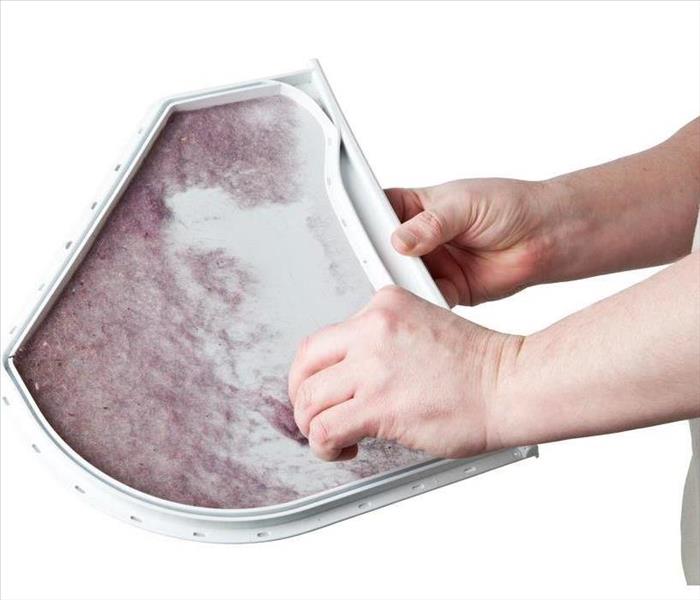 Cleaning a lint trap
Cleaning a lint trap
Tips on Cleaning Your Dryer Vent and Lint Trap
Many homeowners in Arlington Heights, IL, would be surprised to know easily a dryer lint trap can be clogged and turn into a lint fire. Almost three thousand homes a year experience fire damage caused by such a buildup. Here are some tips to properly clean your dryer vent and lint trap.
1. Clean It Every Time
You have probably been told to clean the lint trap before every load, but you may not know why. Lint is highly combustible. Therefore, if a dryer overheats from improper ventilation, a small spark can turn into a lint fire with major damage and a need to call a fire restoration company.
2. Remove All Debris
When cleaning the lint trap, make sure you get each small piece of debris left behind. Every few weeks, it’s a good idea to also run it under water and even use a bit of hand soap on the screen. Be gentle so that you don’t damage the screen or change its shape, and always dry it fully before putting it back.
3. Check the Dryer
It’s important to fully clean the dryer vent as well while the lint trap is out. Particularly if you notice any debris, it’s a good idea to periodically take a vacuum hose and suck out any loose material. This helps clear out clogs and can be done from the outside vent as well.
4. Determine Whether a Deeper Clean is Warranted
If you have signs of a clog, such as clothes no longer drying fully or a very hot dryer when running, you should do a deeper clean to prevent a dryer fire. You can buy a vent cleaning rod at a hardware store to feed it entirely through the vent and push out any excess lint.
Routine maintenance and cleaning will prevent a lint fire from occurring in your dryer. Make sure you clean the lint trap during each load and perform a deeper vent clean every few months. You will have peace of mind knowing that your dryer is running safely.
Smoke and Soot Facts
6/28/2019 (Permalink)
Smoke and soot is very invasive and can penetrate various cavities within your home, causing hidden damage and odor. Our smoke damage expertise and experience allows us to inspect and accurately assess the extent of the damage to develop a comprehensive plan of action.
Smoke and soot facts:
- Hot smoke migrates to cooler areas and upper levels of a structure.
- Smoke flows around plumbing systems, seeping through the holes used by pipes to go from floor to floor.
- The type of smoke may greatly affect the restoration process.
Different Types of Smoke
There are two different types of smoke–wet and dry. As a result, there are different types of soot residue after a fire. Before restoration begins, SERVPRO of Arlington Heights/Prospect Heights will test the soot to determine which type of smoke damage occurred. The cleaning procedures will then be based on the information identified during pretesting. Here is some additional information:
Wet Smoke – Plastic and Rubber
- Low heat, smoldering, pungent odor, sticky, smeary. Smoke webs are more difficult to clean.
Dry Smoke – Paper and Wood
- Fast burning, high temperatures, heat rises therefore smoke rises.
Protein Fire Residue – Produced by evaporation of material rather than from a fire
- Virtually invisible, discolors paints and varnishes, extreme pungent odor.
Our Fire Damage Restoration Services
Since each smoke and fire damage situation is a little different, each one requires a unique solution tailored for the specific conditions. SERVPRO of Arlington Heights/Prospect Heights has the equipment, expertise, and experience to restore your fire and smoke damage. We will also treat your family with empathy and respect and your property with care.
Have Questions about Fire, Smoke, or Soot Damage?
Call Us Today – (847) 637-3445
3 Things to Do About Roof Damage After a Fire
6/25/2019 (Permalink)
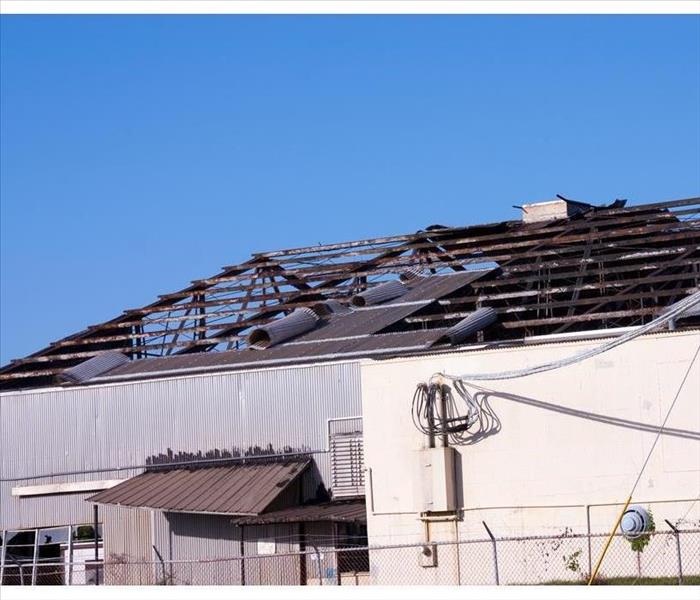 Roof damage in a commercial building in Prospect Heights, IL
Roof damage in a commercial building in Prospect Heights, IL
Tips to Take Care of Damage to Your Commercial Building´s Roof
Discovering that you have roof damage during the fire cleanup process can leave you wondering how to properly address it. In order to protect your business in Prospect Heights, IL, from further damage, there are some important steps you need to take. Here are a few tips to help you take care of damage to your commercial building’s roof.
1. Make an Insurance Claim
Filing an insurance claim is a good idea if your roof has been significantly harmed as a result of fire damage. Be sure to document all signs of damage on your commercial roof in order to provide concrete evidence of the damage. Providing sufficient proof of your loss can also be useful if you plan to show the evidence to a roofing company who can help cover up the damage.
2. Have Tarp Placed on Roof
Covering up the fire damage with tarp can help protect your roof from further harm and ease your fire cleanup efforts. When you utilize tarp services, you can prevent substances such as rain and debris from seeping through your roof and causing additional damage to your building. Rain and snow in particular can cause serious water damage if they accumulate on your roof, so keep these points in mind during the roof repair process.
3. Give Your Roof the Proper Treatment
The care that your roof needs depends on what caused the damage in the first place. If the problem is residual soot, then you may need to address discoloration on your roof caused by soot particles. Have your roof inspected as soon as possible in order to determine exactly how to navigate the fire cleanup process and repair your roof.
Taking care of roof damage in Prospect Heights, IL, can be a less stressful process when you have valuable help and support. Be sure to call cleanup and restoration services to facilitate the roof repair process and have your business return to normal in no time.
Selecting a Fire Extinguisher for Your Home
5/17/2019 (Permalink)
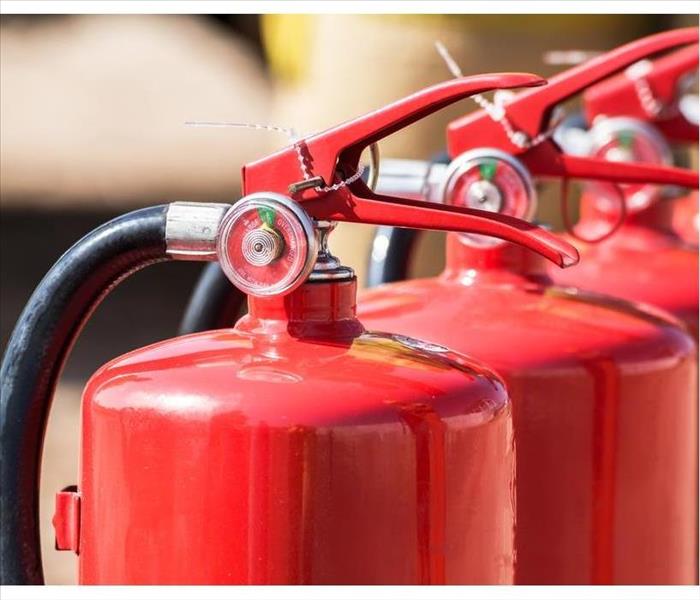 Place an extinguisher in the places most likely to have a fire
Place an extinguisher in the places most likely to have a fire
Selecting a Fire Extinguisher for Your Home
At least one portable fire extinguisher should be in any home. However, the amount will typically vary depending on the size and number of stories to your home. Regardless, the selection of an extinguisher is vital because some will help with certain fires and hurt with others. Therefore, it is crucial to understand the considerations that go into an extinguisher selection before purchase.
1. Location
A home fire is a terrifying thing, but the proper placement of an extinguisher may mitigate it. A two-story home should have a minimum of one extinguisher on each level. However, this number increases when you consider the common locations for fires to occur – the kitchen, laundry room, basement and garage. Therefore, you should place an extinguisher in the places most likely to have a fire.
2. Type
Next, you may want to consider the type of fire extinguisher that would best address the fires that may occur in the previously determined locations. For instance, a kitchen may be more likely to experience a grease and oil fire while a garage may experience a wood fire. Most common extinguisher models for a home come in three types.
- Type A: These extinguishers are used for fires started from ordinary combustibles, like paper, wood and fabric.
- Type B: Used to suppress most grease and oil fires, these extinguishers typically douse flames with dry ice and not chemical powders.
- Type C: If you are worried about an electrical fire, then you want a class C unit. It may be wise to place these extinguishers near computers and other often used outlets.
3. Size and Effectiveness
While having extinguishers proves fire preparedness, you want a unit that will be the most effective against common fires. Therefore, you can contact a fire restoration specialist or the fire department in the Prospect Heights, IL, area to discuss your extinguisher needs.
A single fire extinguisher may be suitable for a small house, but a variety of types may provide you with the best protection. Whatever you decide, make sure to have at least one extinguisher on hand in case the worst happens.
EMERGENCY FIRE DAMAGE TIPS
2/24/2019 (Permalink)
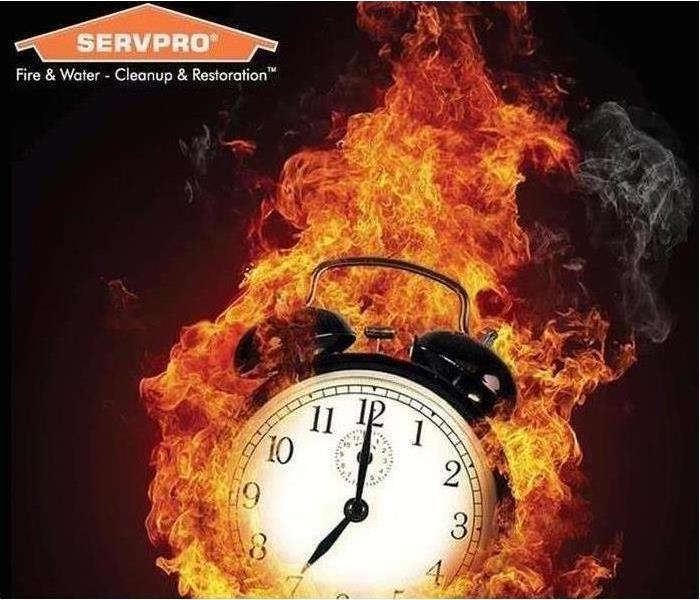 Choose to plan don't choose to react.
Choose to plan don't choose to react.
These emergency tips will assist you in taking proper action until your SERVPRO of Arlington Heights / Prospect Heights arrive. Follow these DOs and DON’Ts to help reduce damage and increase the chances of a successful restoration.
DO:
- Limit movement in the home to prevent soot particles from being embedded into carpet and avoid tracking.
- Keep hands clean. Soot on hands can further soil upholstery, walls and woodwork.
- If electricity is off, empty freezer and refrigerator completely and prop doors open to help prevent odor.
- Wipe soot from metal kitchen and bathroom faucets, trim and appliances.
- If heat is off during winter, pour RV antifreeze in sinks, toilet bowls, holding tanks and tubs to avoid freezing pipes and fixtures.
- Remove soot particles from plants with a damp cloth.
- Change HVAC filter, but leave system off until a trained professional can check the system.
- Tape double layers of cheesecloth over air registers to stop particles of soot from getting in or out of the HVAC system.
DON’T:
- Don’t attempt to wash any walls or painted surfaces without first contacting your SERVPRO® Franchise Professional.
- Don’t attempt to shampoo carpet, rugs or upholstered furniture without first consulting your SERVPRO® Franchise Professional.
- Don’t attempt to clean any electrical appliances (TV sets, radios, etc.) that may have been close to fire, heat or water without first consulting an authorized repair service.
- Don’t consume any food or beverages that may have
- been stored close to fire, heat or water. (They may be contaminated.)
- Don’t turn on ceiling fixtures if ceiling is wet. Wiring may be wet or damaged and cause electrical shock and air movement may create secondary damage.
- Don’t send garments to the dry cleaner. Improper cleaning may set in smoke odor.
Smoke Alarms: LIFE SAVERS
2/12/2019 (Permalink)
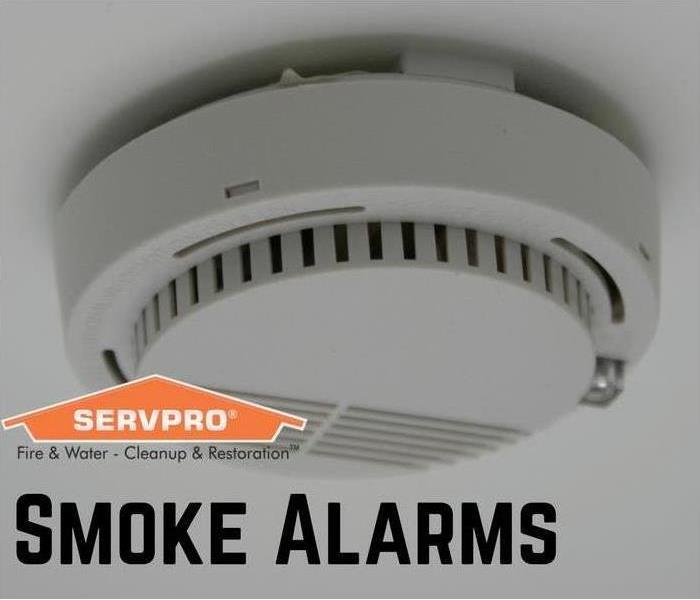 BATTERIES!
BATTERIES!
Smoke alarms save lives when properly installed and maintained, according to the National Fire Protection Association (NFPA).
In homes, smoke alarms should be in every bedroom and on every level, including the basement. In office and commercial environments, check your state requirements or contact your local Fire Marshall to help ensure all codes are met.
Test smoke alarms monthly using the test button. Smoke alarms with non-replaceable batteries need the entire smoke alarm unit replaced every ten years. Other alarms need batteries replaced every year and the unit replaced every ten years. If the alarm chirps signaling low battery, take the proper steps to replace the unit or the batteries immediately. Never disable or remove the battery from an alarm. Almost half of fires where smoke alarms were present but did not activate had missing or disconnected batteries (NFPA).
In larger commercial facilities, hard wired or wireless smoke alarms offer benefits such as not needing to be tested as often and activating throughout the entire building if smoke is detected in just one area (NFPA).
If you need help installing, testing or changing batteries in your smoke alarms, contact your local fire department, an electrician or the American Red Cross.
Be sure your home or workplace has a fire emergency plan in place and conduct regular fire drills. For more information on Emergency preparedness, contact your SERVPRO® Professional. 847-637-3445.
Portable fire extinguishers
2/12/2019 (Permalink)
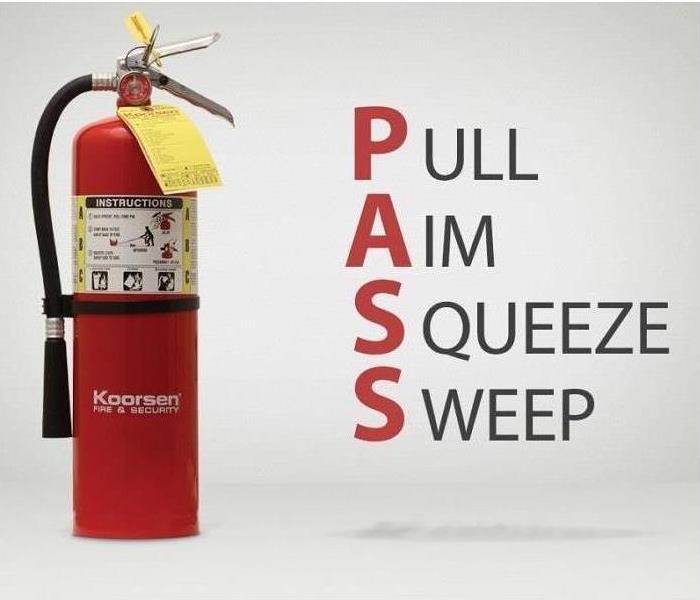 Don't PASS on getting them charged.
Don't PASS on getting them charged.
Portable fire extinguishers can be life and property saving tools when used correctly. In order to operate an extinguisher, the National Fire Protection Association (NFPA) suggests remembering the word PASS:
Pull the pin. Hold the nozzle pointing away from you and release the locking mechanism.
Aim low. Point the extinguisher at the base of the fire.
Squeeze the lever slowly and evenly.
Sweep the nozzle from side-to-side.
Read the instructions on the fire extinguisher and become familiar with them before a fire breaks out. Remember, extinguishers do have limitations. It is also important to ensure you have the correct type of extinguisher for your facility. To find more information on choosing the appropriate class of extinguisher, please visit the NFPA website at nfpa.org.
What is your smoke detector life expectancy?
8/6/2018 (Permalink)
You have a smoke detector in your home, but have you ever wondered what the life expectancy of that alarm is? Smoke alarms save lives. Smoke alarms that are properly installed and maintained play a vital role in reducing fire deaths and injuries, but how long before it should be replaced?
The U.S. Fire Administration for Homeland Security, the National Fire Protection Association (NFPA), the National Electrical Manufacturers Association (NEMA) and the Red Cross agree after working for 87,000 hours, or about 10 years in normal environmental conditions in the home can have an impact on the performance of your smoke alarm.
The NFPA conducted a study, and the results reinforced how important it is for integrators to address the fire safety needs of their clients: 1 in 5 Smoke Alarms Is 10+ Years Old
- Half of Americans (50 percent) have three or more smoke alarms in their current home.
- Almost one in five Americans who have smoke alarms (19 percent) say the oldest smoke alarm they currently have in their home is 10+ years old.
- Nearly one in five Americans who have smoke alarms (18 percent) are not at all sure how old the oldest smoke alarm they currently have in their home is.
- When asked how often they should replace smoke alarms, nine in 10 Americans (90 percent) did not select the correct answer, which is at least every 10 years.
SERVPRO of Arlington Heights/Prospect Heights wants you and your family safe. Keep these tips in mind when checking your smoke alarms.
Bonfire Safety Tips
7/16/2018 (Permalink)
Now that it is summer, it is bonfire time! According to a report from the United States Fire Administration, summer is one of the most dangerous seasons for fire-related injuries and deaths. Fortunately, there are plenty of ways to protect yourself and your loved ones while still having a great time. Here are some great tips from the American Fire Safety Administration.
Choose a location for your bonfire where it will not spread. Never build a fire near any dry leaves or grassy areas or under overhanging tree branches. Before building a bonfire, clear away all shrubbery and vegetation from the area, dig a pit for the fire, and surround it with rocks.
Be smart about lighter fluid. Do not store gasoline, liquid fire starter, or any other type of flammable liquid near the campfire. It's too easy for stray flames to ignite these materials.
Never light a bonfire if you do not have the means of extinguishing it. Always keep plenty of water and a shovel near the campfire to use in an emergency and to put the campfire out when you are finished using it.
If you experience a fire at your home while enjoying a beautiful summer night, SERVPRO of Arlington Heights/Prospect Heights at 847-637-3445.
What Happens After Your Fire?
6/28/2018 (Permalink)
We all know that for an emergency you call 911, but what happens after the fire department leaves and you have a damaged home or business? You call SERVPRO of Arlington Heights/Prospect Heights, that's what you do! We are here to help you 24/7/365. Give us a call at 847-637-3445 for all your fire and water emergency needs.
Fires can leave behind soot and smoke that needs to be cleaned. SERVPRO of Arlington Heights/Prospect Heights is here to help! Cleaning up after soot and smoke is no small task, but our trained staff will be able to clean your home or commercial property and return it to you just "Like it never even happened." We are here to help 24/7/365 for all your restoration needs.
Grilling Tips
6/13/2018 (Permalink)
According to the National Fire Protection Association (NFPA),” In 2014, 16,600 patients went to emergency rooms because of injuries involving grills”. The NFPA has listed several great tips for grill safety, we would like to share with you.
- Grill outside and away from any structures
Charcoal and gas grills are designed for outdoor use only. However, NFPA reports that more than one-quarter (27 percent) of home fires started by outdoor grills began in a courtyard, terrace or patio, and 29 percent started on an exterior balcony or open porch. Pay attention to overhanging tree branches when you set up your grill.
- Make sure your grill is stable
Only set up your grill on a flat surface and make sure the grill can’t be tipped over. Consider using a grill pad or splatter mat underneath your grill to protect your deck or patio.
- Keep your grill clean
Remove grease or fat buildup from both the grill and the tray below the grill. If you are using a charcoal grill, allow the coals to completely cool off before disposing of them in a metal container.
- Check for propane leaks on your gas grill
Before the season’s first barbecue, check the gas tank hose for leaks by applying a light soap and water solution to the hose and then turning on the gas. If there is a propane leak, the solution will bubble. Other signs of a propane leak include the smell of gas near the barbecue or a flame that won’t light.
- If the flame goes out, wait to re-light
If you are using a gas grill and the flame goes out, turn the grill and the gas off, then wait at least five minutes to re-light it.
- Take care around the grill
Never leave a lit grill unattended. Don’t allow kids or pets to play near the grill. Never try to move a lit or hot grill, and remember the grill will stay hot for at least an hour after use.
- Be careful with charcoal starter fluid
If you use a charcoal grill, only use charcoal starter fluid. If the fire starts to go out, don’t add any starter fluid or any other flammable liquids to the fire. Consider using a charcoal chimney starter, which uses newspaper to start the fire instead of starter fluid.
- Wear the right clothing
Clothing can easily catch fire, so be sure your shirt tails, sleeves or apron strings don’t dangle over the grill.
- Be ready to put out the fire
Have baking soda on hand to control a grease fire and a fire extinguisher nearby for other fires. If you don’t have a fire extinguisher, keep a bucket of sand next to the grill. Never use water to put out grease fire.
Enjoy, relax, and most of all use these tips to stay fire safe. However, we all know accidents happen. If you should find you have a need for cleaning up after a fire event, SERVPRO of Arlington Heights/Prospect Heights is here to help make it “Like it never even happened.” Give us a call at 847-637-3445.
What Happens After Your Arlington Heights Area Fire?
6/4/2018 (Permalink)
We all know that for an emergency you call 911, but what happens after the fire department leaves and you have a damaged home or business? You call SERVPRO of Arlington Heights/Prospect Heights, that's what you do! We are here to help you 24/7/365. Give us a call at 847-637-3445 for all your fire and water emergency needs.
Fires can leave behind soot and smoke that needs to be cleaned. SERVPRO of Arlington Heights/Prospect Heights is here to help! Cleaning up after soot and smoke is no small task, but our trained staff will be able to clean your home or commercial property and return it to you just "Like it never even happened." We are here to help 24/7/365 for all your restoration needs.
Spring Cleaning Fire Safety Tips
5/31/2018 (Permalink)
Spring has finally sprung in Arlington Heights! Time to start thinking about cleaning out all the built up clutter and stagnant air from the winter. That also means time to take stock of some things that may be a fire hazard around your home during your cleaning.
According to NFPA, the leading cause of home clothes dryer fires is failure to clean them. Lint catchers need to be cleaned before you throw in the next load of laundry. Another safety tip for around your dryer area is to keep all boxes, and other items that can catch on fire away from the dryer while it is in use.
Testing your smoke alarms saves lives. Gently vacuum or sweep the cob webs away from your smoke alarm. Remove anything that might be blocking the sensors. While you are up there, change your batteries as well.
The NFPA reports that an annual average of nearly 48,000 electrical fires occurred in U.S. homes between 2007 and 2011. Make sure to replace any electrical cords that are damaged or loose, and try to avoid running any cords under carpets or across doorways where they’re more likely to get damaged. Any cords with damaged plugins or unprotected wires should be discarded immediately.
Lastly, when working with, or disposing of, and potentially hazardous chemicals, never use the same container to mix them, which could cause a deadly reaction and check with your local municipality for disposal programs, or instructions on proper disposal methods.
SERVPRO of Arlington Heights/Prospect Heights wants you to have a safe and fun spring season. However, things happen, and if you experience a fire in your home, give us a call at (847) 637-3445. We are always “Faster to any sized disaster”.
Family Fire Safety
5/22/2018 (Permalink)
Would you know what to do if a fire started in your home? Would your kids? According to NFPA, in 2013, 334 children died in home fires. Eighty-seven percent of all fire-related deaths are due to home fires, which spread rapidly and can leave families as little as two minutes to escape once an alarm sounds. Fires are not just a problem in the United States. In 2008, nearly 61,000 children around the world died due to a fire or burn.
Kids Health has some great tips for parents to review with their families about fire safety.
- Working smoke alarms reduce the chances of dying in a fire by nearly 50 percent. They are a critical first step for staying safe, but in order to be effective, they have to be working properly. For the best protection, install smoke alarms on every level of your home and in every sleeping area.
- Teach kids never to play with matches and lighters. Make a habit of placing these items up and away from young children.
- Create and practice a home fire escape plan with two ways out of every room in case of a fire. Get a stopwatch and time how fast your family can escape. The kids will love it.
- Children should know how to respond to the sound of a smoke alarm. Teach them to get low and get out when they hear it. A child who is coached properly ahead of time will have a better chance to be safe.
- Use common sense in the kitchen. Limit distractions when cooking and don’t leave a hot oven or stove top unattended.
- Blow out candles before you leave the room or before you go to sleep.
In the event of a fire in your home, follow these safety tips to keep your family safe. Then after all family members are taken care of, and the fire department has cleared your home, call SERVPRO of Arlington Heights/Prospect Heights at 847-637-3445. We are always here to help!
What you can do until help arrives
6/14/2016 (Permalink)
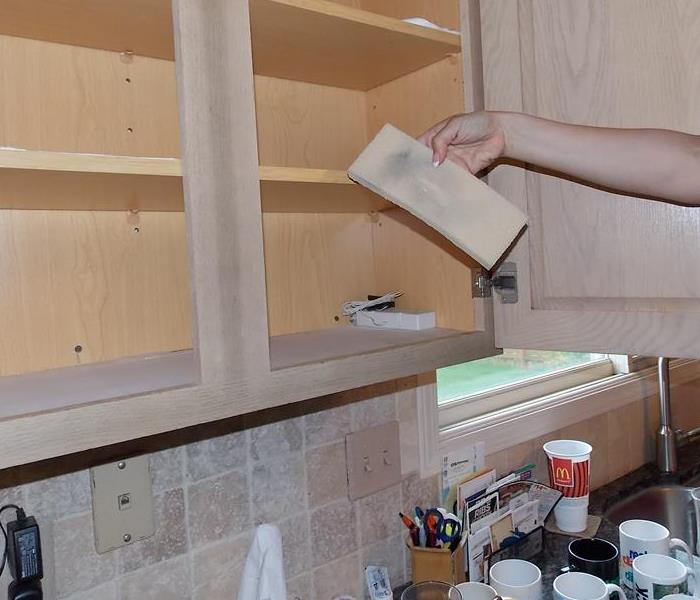 Soot affects everything including the inside of your cabinets! The fire occurred in the basement yet the soot made it into the kitchen cabinets.
Soot affects everything including the inside of your cabinets! The fire occurred in the basement yet the soot made it into the kitchen cabinets.
The first 48 hours after a fire damage can make the difference between restoring versus replacing your
property and personal belongings. SERVPRO’s 1-4-8 Service Response Guidelines can help prevent fire
damage from creating long-term problems. SERVPRO Franchise Professionals provide timely response
with mitigation services ranging from fire, smoke, and soot removal to contents claims inventory and
document restoration. These services help ensure your property, belongings and memories are restored
to pre-loss condition when possible. SERVPRO Franchise Professionals are available 24-hours a day, 365
days a year to help you regain control quickly. Below are steps you can take until a vendor such as
SERVPRO arrives.
Limit movement in the home to prevent soot particles from spreading and additional damage from occurring.
Place clean towels or old linens on rugs and high traffic areas and upholstery.
Coat chrome faucets, trim and appliances with petroleum jelly or oil.
Place aluminum foil or wood blocks between furniture legs and wet carpet.
Do not wash any walls or painted surfaces.
Do not shampoo carpet or upholstery.
Do not clean any electrical equipment.
Do not sent clothing to a dry cleaner since improper cleaning may set smoke odor.






 24/7 Emergency Service
24/7 Emergency Service














